For a long time it was unknown how the service would work iCloud Drive. Will there be a separate client for Mac and Windows? How to open files in the cloud from mobile devices? What should OS X Mavericks users do?
Actually new cloud service Apple is an analogue of Dropbox and Yandex.Disk Drive and works on the same principle. If previous version While iCloud was only a thin layer for applications and services, the new service provides the user with full access to content and opens up broader opportunities for using the cloud.
Unfortunately, at launch Apple did not offer iPhone owners and iPad a separate client for accessing files in iCloud Drive. Yes, third-party software can indeed work with content in remote storage, but it is not at all necessary. Due to this limitation, iCloud Drive cannot yet be called a full-fledged alternative to Dropbox.
How to View Files in iCloud Drive Using Cloud Opener
If you need an application to view iCloud Drive content on iPhone and iPad, you will have to use the solution third party developers. For example, free program Cloud Opener.
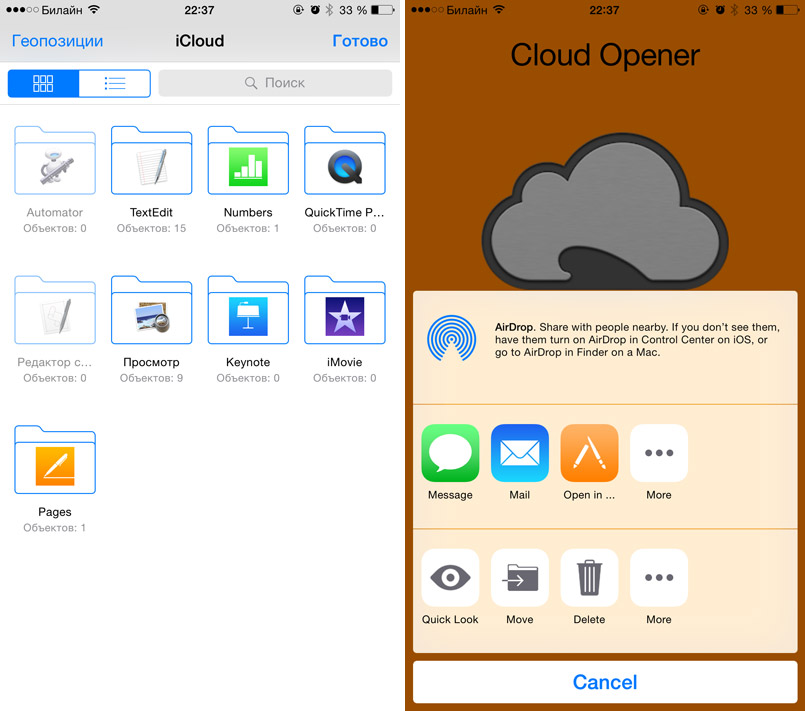
Despite the promising name, the client has a number of limitations. For starters, Cloud Opener can be used solely to view files in the cloud. The program allows you to sort files by name, modification date and tags, and shows the size of the documents. However, there is no talk of saving content to the device or editing it.
At the same time, Cloud Opener can interact with other applications as part of extensions in iOS 8. If the utility's capabilities are enough for you, you can download it from this link.
How to work with files in iCloud Drive using Documents 5
Documents 5 offers more features than previous application. And unlike alternative solutions, like Goodreader, this client has a user-friendly interface. Plus it's free.
Documents 5 is easy to use. Just open the application on a device with a logged-in Apple ID, go to the tab with the cloud icon on the bottom panel and click on the iCloud Drive link at the top. With Documents 5 you can view almost any document and graphic files, as well as edit texts, work with PDF, listen to music, etc.
iCloud is a cloud storage, a virtual place for saving user information. Protected by login and password, gives access with various devices and gadgets.
This data storage location is one of Apple's projects. And in this article we will look at how to log into iCloud from a computer.
How to log into iCloud from a computer from the official website
Regardless of which browser will be used to enter the storage (, Firefox, Opera, etc.), you need to go to the official iCloud website.
By the way, even the operating system used does not matter. After all, some users believe that since iCloud belongs to the Apple company, they can log in from browsers assigned to it.
Practice shows the reality of logging in from any operating system.
So, after logging into the official website of the storage facility, a window will appear on the screen where you will need to enter your login and password.
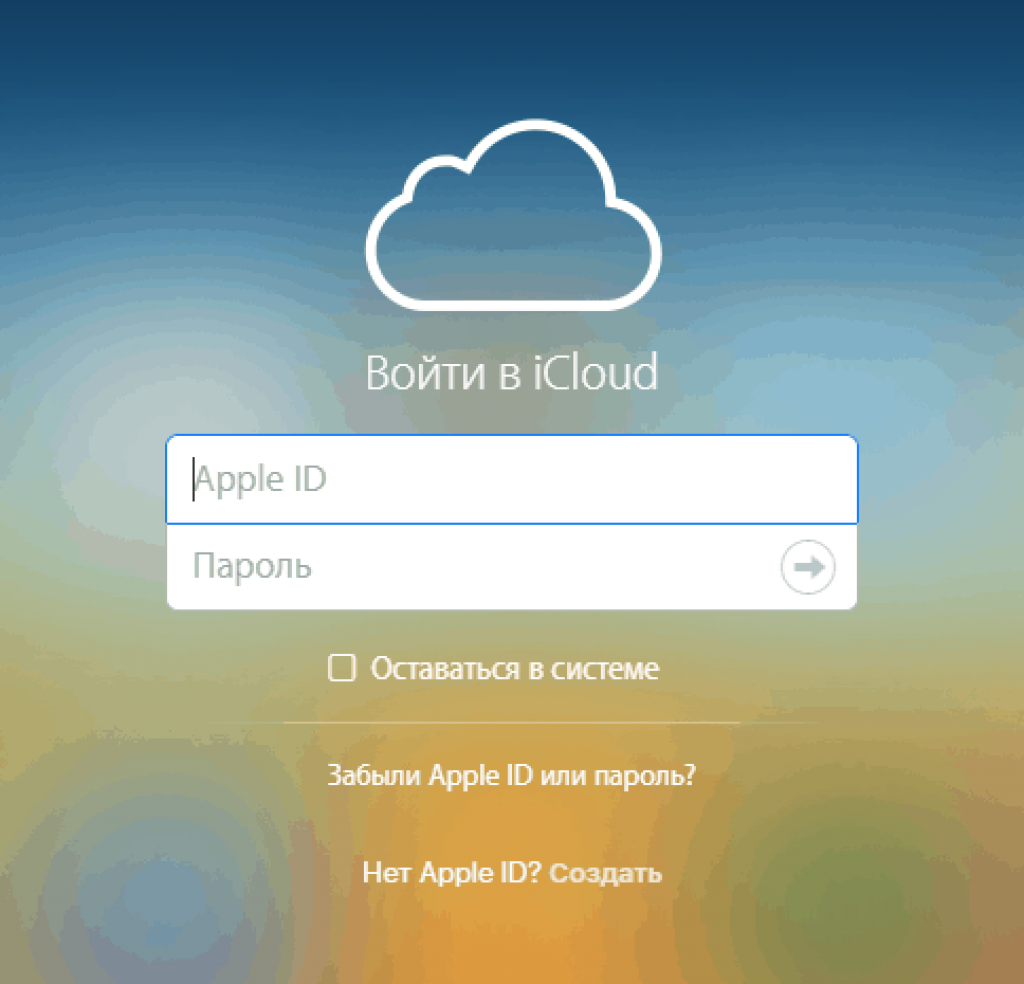
After carrying out such manipulations, it will be possible to manage those positions that were previously saved under this login.
Usually this is email, contacts, pictures and photographs, notes and recordings, various reminders, etc.
If you want to use data located on this moment on your phone, move the circle until it turns green, otherwise it will remain gray.
What is available in the storage when you log in from your computer
Along with the question of how to log into iCloud from a computer, interest also arises regarding the areas of its use.
That is, what information and data can be stored there, how confidentiality works with such possibilities.
It should be noted that initially you need to create a login and password that are as reliable as possible. That is:
- There must be letters in both Latin and Cyrillic alphabet.
- Large and small letters are good to use.
- Introduce numbers there, and, if the rules allow, signs.
- Also, these codes should not be based on personal data, especially known and accessible to many people.
You can put the positions you want in the cloud. There is no total copying here; everyone chooses for themselves what to save and what they do not want to remember or use.
So, the list includes the following provisions that you can control:
1 Contacts. This is access to a list of people with their data, phone numbers, addresses, emails and other data recorded in the iPhone. If necessary, you can transfer this list directly to the PC’s memory, and also save it in a format suitable for use on Android.
2 iCloud Mail, you can also log into it from your computer if you mark its saving in the iPhone settings. It should also be noted that you can log in and fully manage your mail data; even the interface is almost no different from the version on the iPhone.

3 Calendar. As strange as it may sound to some, many users use the calendar on their phone as a diary, that is, they reproduce the daily plan in the calendar. This is convenient when you have a lot to do, and reminder notifications help with this. That is why, in order to avoid various incidents, it is preferable to copy and synchronize this data, just so as not to disrupt the schedule of plans.
4 Photos. This is one of the most popular positions saved in the cloud, because after taking pictures or on your iPhone, you don’t need to resort to additional portable devices or programs, and you don’t need to do anything at all. Just from any PC or gadget connected to the Internet, go to the official website, enter your cloud data and enjoy browsing.
5 Cloud Drive. This system involves saving the results of using any applications in the cloud, which brings the same convenience as using cloud photos.
6 Notes. This is very reminiscent of calendar saving, only here you can make entries in a different direction, not just planning and reminders. Saving these notes is very common precisely because it is secure and always at hand.
7 Applications that are allowed in the settings. These are location finders for friends and acquaintances, phone search engines, phone settings and more.
Remember that you can turn off synchronization at any time and unwanted data will not end up in storage.
is a cloud storage from Apple in which you can store any files and have access to them from anywhere mobile device and computer. iCloud Drive fits seamlessly into OS iOS and OS X: Starting with iOS 9, iCloud Drive has its own app that is included with the system.
The basic principle of iCloud Drive: the user edits a file on one device, at any time he can switch to his other device and start editing the file there.
iCloud Drive works on iOS 8 or later, a Mac running OS X 10.10, and Windows computer With installed application iCloud for Windows (requirements: Windows 7 and later).
You can also access iCloud Drive on the website.
How to enable iCloud Drive?
In OS X Yosemite and OS X El Capitan. If by some coincidence iCloud Drive is not yet enabled, then you need to go to System Preferences->iCloud. And check the iCloud Drive box.

IN Parameters you can see a list of programs that can store data in iCloud Drive.
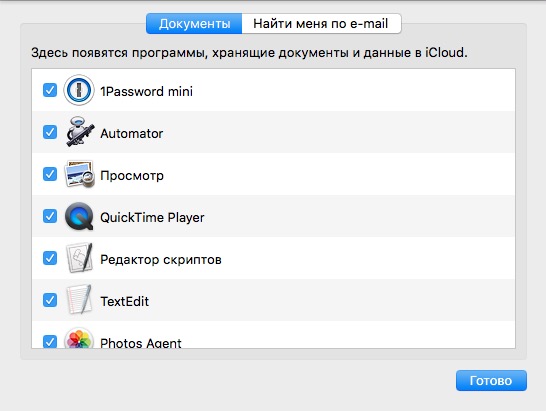
On the iPad, you need to go to Settings->iCloud->iCloud Drive and turn on the iCloud Drive checkbox.
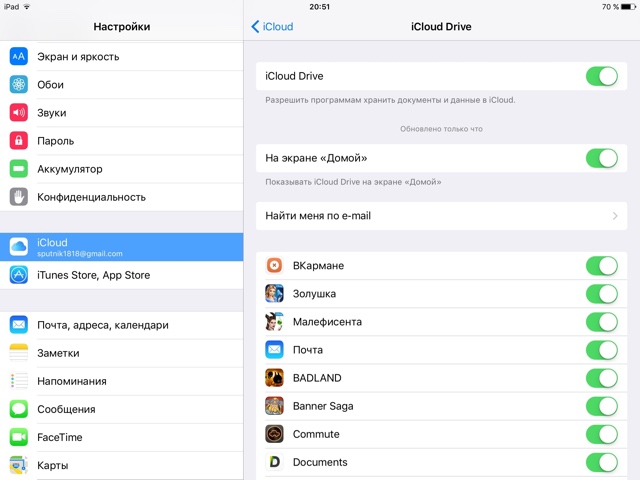
If you immediately enable the “On the Home Screen” item, then on one of the desktops in iOS appears separate program iCloud Drive.
How iCloud Drive works in OS X
In OS X, working with the cloud is extremely simplified. In Finder, a special folder appears on the left. It contains folders from applications that store data in iCloud Drive. You can also create your own without any problems and throw any files there.
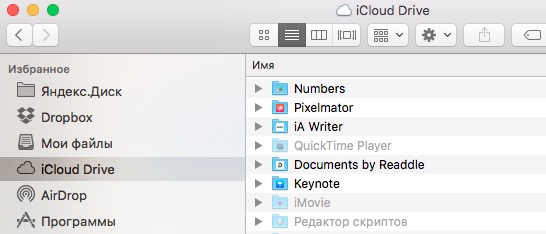
iCloud Drive on Windows
Needed on a computer installed program iCloud for Windows (you can download it from a special page on the Apple website). In it you need to check the iCloud Drive box.
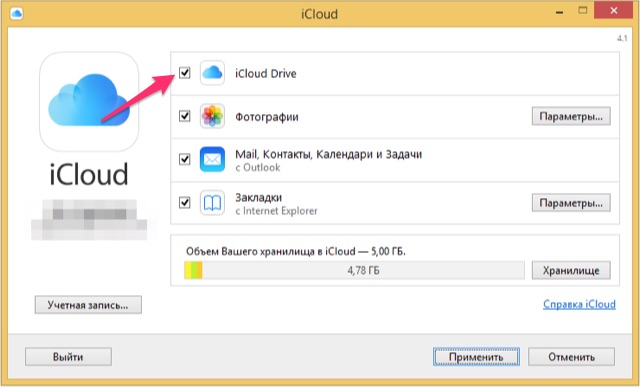
The iCloud Drive folder will appear in Explorer. You can use it like a regular folder, but all the data in it will go to the cloud.
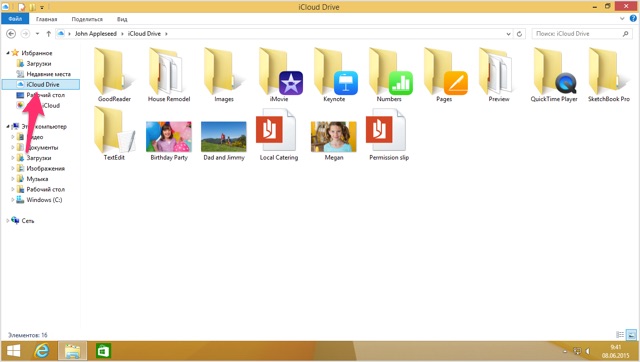
How iCloud Drive works on iPhone, iPad and iPod Touch
In iOS 8, iCloud Drive seems to exist and even work, but the user does not see its visual embodiment. Applications such as Pages, Numbers, iA Writer, etc. save files to the cloud and store them there. But Documents can even create folders in the cloud, but still the programs only have access to their own folders.
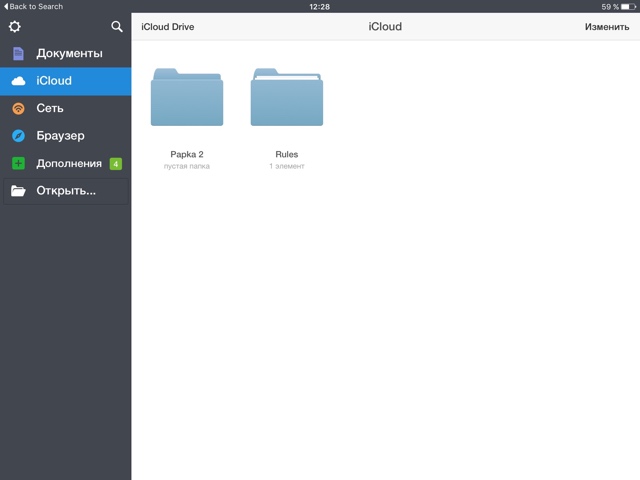
As I wrote above, iOS 9 finally has a special iCloud Drive application.
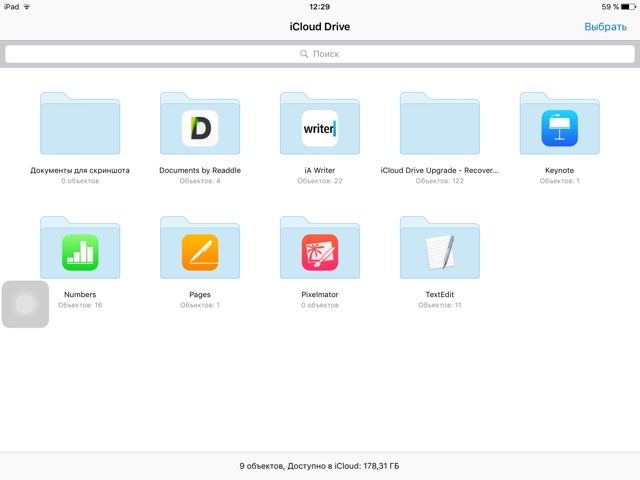
In it you can finally manage folders and files in the cloud. Create new folders, move files, delete.

You can also open files, although for some reason they open slowly. The opening speed is unstable.

Sending documents
iCloud Drive is a secure cloud. So secure that the file or folder in it cannot be shared. Perhaps, for now.
But documents from iCloud Drive can be opened in another program or sent by mail, messages, etc.

In iOS 9, the standard email app now has the ability to add attachments from iCloud Drive. You need to tap on the text of the letter and select “Add attachment” from the menu

The iCloud Drive window appears, in which you can select files to attach to the letter.
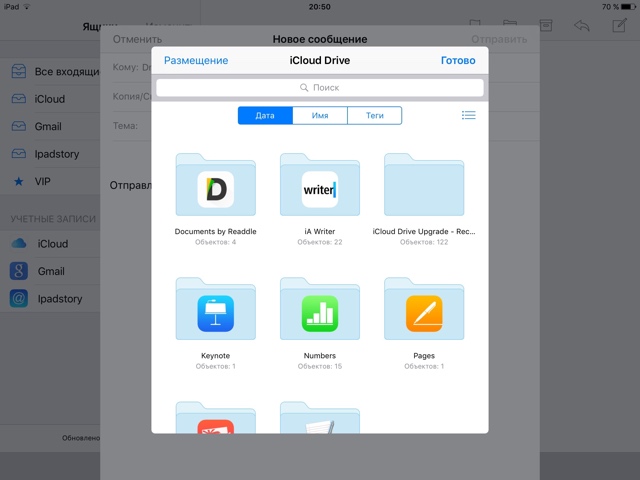
iCloud Drive and other cloud storage
iCloud Drive is a clear attempt to wean Apple fans away from competitors' cloud storage services.
The main advantage of iCloud Drive is that the cloud is already built into iOS and the iCloud ecosystem. That is, if a user buys space under , this is free place also available for iCloud Drive.
Prices are generally reasonable:
- 5 gigabytes free
- 20 gigabytes - 39 rubles per month
- 200 gigabytes - 149 rubles per month
- 500 gigabytes - 379 rubles per month
- 1 TB — 749 rubles per month
Flaws:
1) unlike competitors' offerings, iCloud Drive cannot share files and folders. Perhaps this jamb is just a matter of time.
2) while some kind of limitation is felt. For example, on the website icloud.com you cannot update folders in iCloud Drive, and in the program on the iPad you cannot specify files that need to be stored offline.
So far, we seem to be seeing the first version of Dropbox, although what is stopping Apple from taking the best developments of its competitors right from the start and implementing them in its application?
What else do you need to know about iCloud Drive?
The maximum file size in iCloud Drive is 15 gigabytes. There are no file type restrictions.
Android and iOS are extremely reluctant to make steps towards each other, so such basic things as accessing online storage or transferring data often have to be done using third party applications. This also applies to opening iCloud on an Android device: you can access the service from an iPad, iPhone, Mac, PC, but Android devices remain outside the list of allowed ones.
There is no full standalone iCloud app for Android, so you have to search for every operation, be it transferring contacts, syncing your calendar, or copying files. new way. Theoretically, the solution could be to use the iCloud web interface. It is available on Mac and PC, but if you try to go to icloud.com from an Android device, you will see a notification that the browser is not supported. Interestingly, on Windows you can use not only the web version, but also a separate application that is configured like this the same as on Apple devices. At the same time, Android remains a completely isolated environment, with which it is very difficult to establish communication from iOS or Mac OS.  If you search for applications that work with iCloud, in Google Play, then you will only find programs that perform strictly defined functions:
If you search for applications that work with iCloud, in Google Play, then you will only find programs that perform strictly defined functions:
- Sync for iCloud – for calendar synchronization.
- Synchronization for iCloud Mail – synchronization of the mail service.
- Sync for iCloud Contacts – contact synchronization.
If you only need iCloud to transfer contacts or synchronize your calendar, then the functionality of these applications will be quite sufficient. For synchronization Email you can do without it altogether third party software. You just need to configure mail client on Android.
Setting up iCloud mail on Android
Usually two clients are installed on Android - Gmail for Google mail and Email for others postal services. To set up receiving emails from your iCloud mailbox, use the built-in Email app.
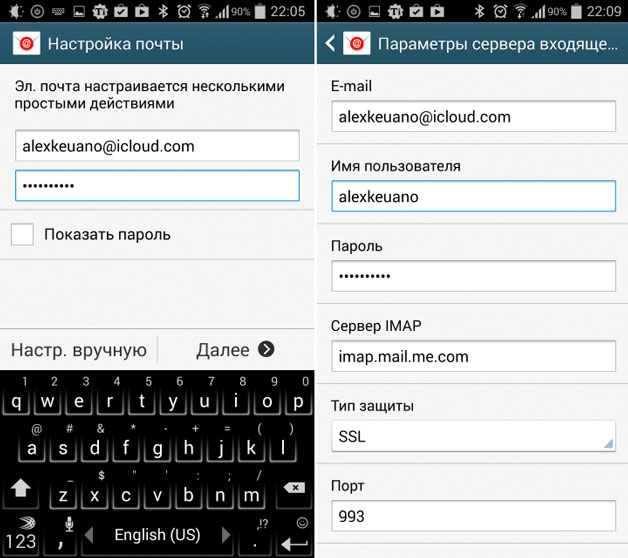
- Email – repeat the iCloud email address.
- The username is part of the email address before @icloud.com.
- Password – repeat the email access code.
- Server – imap.mail.me.com.
- Security type – SSL or SSL with all certificates accepted.
- Port – 993.
The IMAP path prefix does not need to be filled in. After entering all the data, click “Next” to begin setting up the SMTP server.
- Address – smtp.mail.me.com.
- The username and password are the same as in the IMAP settings.
- Security – SSL or TSL.
- Port 587.
If prompted for authentication, click Yes. After setup, all emails from iCloud will be automatically duplicated into the email client on Android. If the procedure turns out to be too complicated, you can significantly simplify the task of synchronizing data by using special applications– for example, myMail or K-@ Mail. There is no need to separately configure IMAP and SMTP; you just need to specify the iCloud email address and password.
Other ways to access iCloud
If you are looking for how to access iCloud services from Android not only for email messages, but also to gain access to other data, then you will have to look for other ways to synchronize information. Connecting iOS with Android is not so easy, but there are still proven methods.
If you need to transfer contacts, you can use the built-in capabilities of the Google Contacts service or transfer the data as a vCard file. In the second case, you will first have to log into iCloud from your computer, export the data to a separate file, and then import it into Google services. The first method is much more convenient:
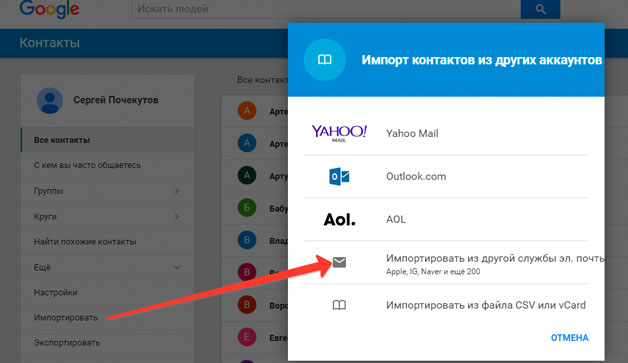
The only drawback of this method is that during synchronization, some independent company gets access to the data. Therefore, many users ignore this method, preferring to transfer contacts in a file or use CardDAV applications.  CardDAV allows you not only to transfer contacts, but also enable their synchronization, that is, as soon as the data on iCloud is updated, similar changes will occur in the Android phone book. The main thing is to specify the server p02-contacts.icloud.com, Apple ID and enable synchronization only from the server to the phone.
CardDAV allows you not only to transfer contacts, but also enable their synchronization, that is, as soon as the data on iCloud is updated, similar changes will occur in the Android phone book. The main thing is to specify the server p02-contacts.icloud.com, Apple ID and enable synchronization only from the server to the phone.
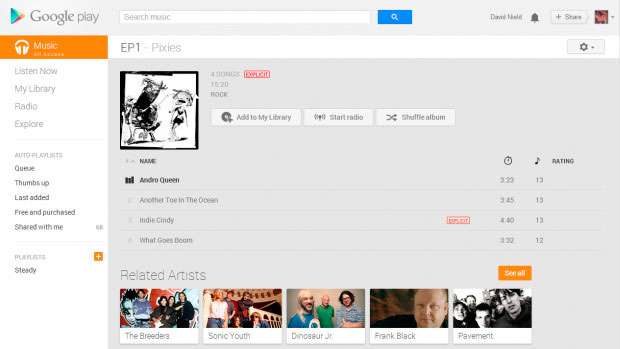 The service has a client for iOS, so you can easily access tracks stored on iCloud. Another way is the Amazon Cloud Player app. It also has clients for iOS and Android, which can be combined with one account, resulting in access to a common music collection.
The service has a client for iOS, so you can easily access tracks stored on iCloud. Another way is the Amazon Cloud Player app. It also has clients for iOS and Android, which can be combined with one account, resulting in access to a common music collection. If you purchased content from a paid YouTube channel, you can easily access it from the official video hosting client on Android and iOS. Online services – in general The best way viewing content. They work the same on any device without making any special system requirements. 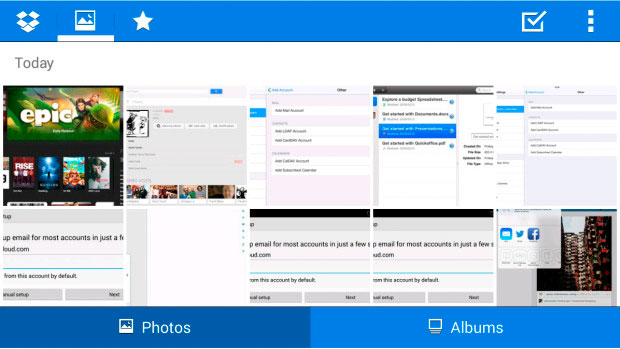
Using different cloud storage services other than iCloud is another great method for transferring data from iPhone to Android. For example, Dropbox has clients for Android and iOS, so you can seamlessly access files that are actually stored on the same cloud, with different devices. iCloud for Android remains unavailable for now, so trying to pull files from it onto a device running Google’s OS is a difficult and demanding task large quantity unnecessary movements.
Hi all! No matter how cool, wonderful and convenient the cloud storage service iCloud is, it is still nowhere without its drawbacks. And the most important inconvenience is that your data is physically located far from you (), and it is quite difficult to access it without a device. But difficult does not mean impossible. Now I will tell you how to view photos in iCloud (although the matter is not limited to photos) without using an iPhone, iPad and other iPods.
What is generally needed for this:
- Computer.
- Know your Apple ID and password.
- It is necessary that there is at least one backup copy of the device in the cloud. How to create - read.
All! With just one Apple ID you can find out absolutely all the information stored on your iPhone, iPad, iPod:
- Contacts.
- Notes.
- Calendars.
- Photos.
- Video.
- WhatsApp correspondence.
- Browser bookmarks.
What can this be useful for? Imagine that your iPhone suddenly breaks down or, and on it is everything that you really need and need right now! Since iCloud backup is created automatically, there is a high probability that your data flew to the “cloud” during the last charge. So we need to take them out of there.
How will we do this? It turns out that there are specialized programs that download backup iCloud copies and “reveal” them. Today we will look at Wondershare Dr.Fone for iOS. The program costs money, and quite a good one – $69.99. trial version present.
How to view photos and other data in iCloud
Let's install the utility, I think there shouldn't be any difficulties. The process is not much different from any other program. It's almost as easy as that :). After launch, we are interested in the item on the right top corner– Recover from iCloud Backup File. Click.
It is suggested to enter an Apple ID (if you have no idea what it is, the answer is written on how to register). After specifying the ID account- click on the arrow (next to the password entry field).

After the program verifies the correctness of the specified data, it will display all the latest backups associated with your account. All that remains is to select the one you need and click Download in the “State” field.
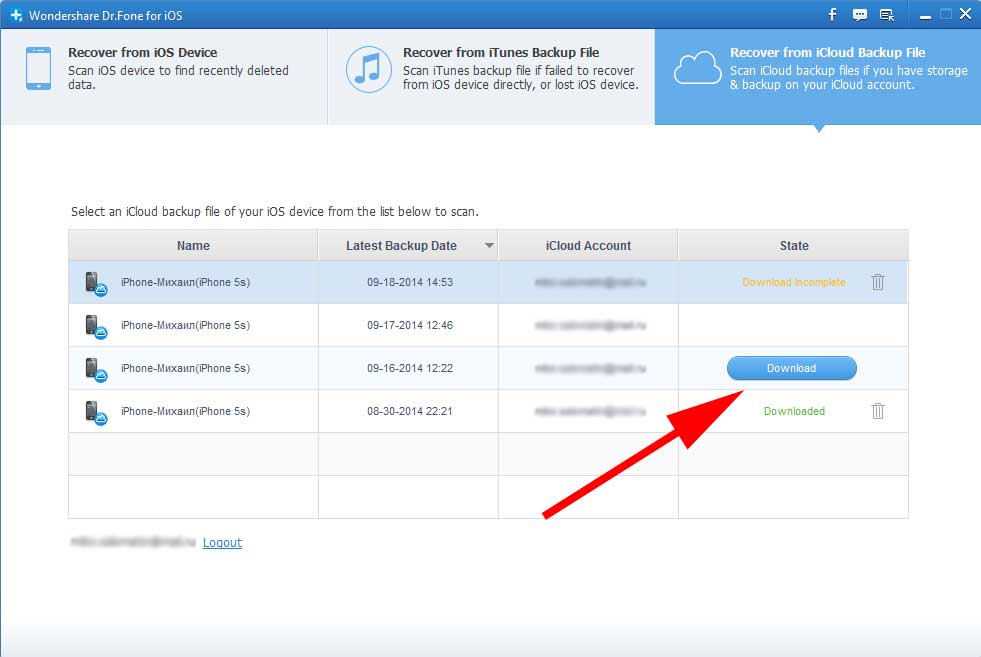
That's it, you can go drink tea and mind your own business. The program has started downloading backup copy. The process is not fast, the time depends on the Internet channel and the amount of data. My 1.5 gigabyte copy took about 1 hour to download.
After this, you will have the opportunity not only to view photos from iCloud, but also to download them to your computer. And also in front of you, at your fingertips, all the information!

Note - to restore photos and other information, click right click mouse over the data and select:
- Recover checker – restore all marked files.
- Recover highlighted - only this file.
Free options to view iCloud content on your computer
As I already mentioned, there are other programs like this. Unfortunately, they are all paid and cost a lot of money. How can I view photos and other data stored in iCloud using free methods? Here the user’s choice is not so great, but there are still a couple of ways out of this situation:
- Set up a photo stream. To do this, install it on the PC, and enable the necessary option in the device settings.
- Use the web interface cloud storage. Notes available Mailbox, contacts, documents.
Finally, I would like to remind you, do not share your Apple ID with anyone. After all, as you and I saw, knowing only him, you can look at all the photographs, correspondence and other important information absolutely without your knowledge!
P.S. Have questions? Write in the comments and be sure to like! No questions? Click “like” anyway!
